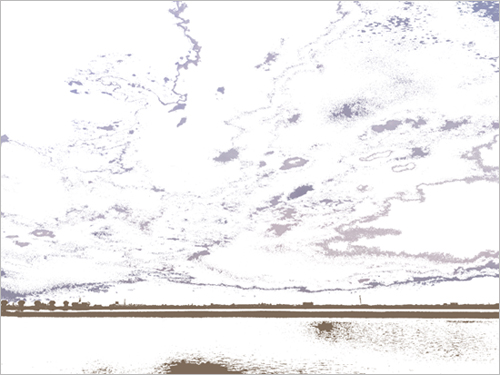*We are pleased to announce that the new exhibition date of ‘KIWA-KESHIKI’ ~Isemoude 2~ by Yoshitaka Nanjo has been finalized as below. We look forward to seeing you soon!
'KIWA-KESHIKI' ~Isemoude 2~

YUKARI ART CONTEMPORARY is pleased to announce Yoshitaka Nanjo's solo exhibition 'KIWA-KESHIKI' ~Isemoude 2~’.
The exhibition will open on Saturday 14 May 2011 at our gallery’s space in Meguro, Tokyo.
Nanjo creates landscape paintings using actual soil based on his field-work, following the principle of ''believing things I feel with my body and taking a down-to-earth approach''. He is especially interested in art in the late Edo period, the time when landscape painting enjoyed greatest prominence in Japanese art history. Additionally, he is also interested in the history of massreligion in the Edo period. Nanjo aims to ''actually see and consider with his own eyes whether or not there is still something that indicates a model landscape in our contemporary Japanese landscape''. To achieve this aim, he has been working on many subjects such as 'FUJITOZAN ~climbing Mt.Fuji~'(Fuji worship), 'Koshu Dochu'(Edo Five Routes), 'Tokyo Bay'('Edo-mae' in front of Edo bay=Tokyo bay culture), 'Kumano Kodo'(animism) and 'Isemoude'(travel culture of Shinto and Edo period). These themes are based on Japanese people's religious views, manners and landscape views that came from
their travels or journeys. Nanjo says ''I think that painting landscape inevitably came from the act of walking in Japanese history. So, I actually go to the subject places, I walk with my legs and I observe the scenery of towns and mountains.''
He also tries not to fill the paintings completely with information and force viewers to see the work as a narrative, but instead tries to produce landscape paintings as if they can arouse viewers' aesthetic sensibilities with very little information, almost as if his image is just about to reach viewers. Because of this, his works seem very simple. However, Nanjo's actual technique to create paintings is unimaginably complicated and rigorous.
First of all, he selects a scene he wants to paint whilst walking and takes pictures. He then collects earth and soil that strongly show the character of the area. Secondly, he dissolves images in the pictures he took, making drawings by hand or analyzing using a computer until the scenery becomes objects. He also dissolves earth and soil, screening until they get as small as pigment. Finally, according to the digital outputs of images he got after all the processes above, he repeats analog processes over and over, such as putting earth and soil on cotton coloured in white as if they are pigment and painting with acrylic. ''In doing so, a landscape will be produced that amounts to more than the original landscape - or a landscape completely different to the original will appear in the painting. At that moment, the background coloured in white many times will be changed into void space with boundless colours. Layering soil acrylic, and digital work, analog work creates conflicting spaces in the painting.''
This exhibition is the second/final part of Nanjo's new series 'Isemoude', which refers to the route between Nihonbashi and Ise Shrine in Mie prefecture. In the first part of the series, which was held from the end of 2009 to the beginning of 2010, scenery from Nihonbashi to Fukuroi, a town that traditionally provided accommodation, was expressed. In this final part of the series, scenery from Fukuroi to Ise Shrine will be presented. About 10 new paintings will be exhibited.
*Comment from Artist:
''I want to find a 'new landscape' at the margins, coming up from the layers of objects, where places become landscapes and where landscapes become other landscapes''
We would be very grateful if you could introduce Yoshitaka Nanjo's solo exhibition through your media.
Yoshitaka Nanjo Bio: